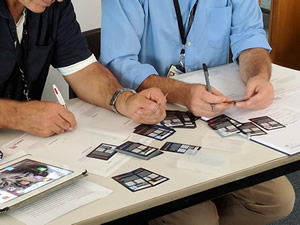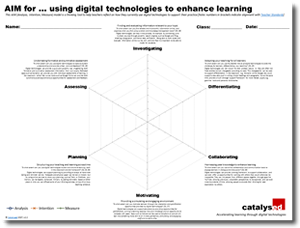Design
 |
| A Design module workshop |
The Design module involves making changes to existing practices in order to align the needs of teachers with the digital technologies that have the potential to support those needs. Using practical hands on tools and techniques, such as the AIM models and Tech Trumps®, teachers can reflect on their own practice and design new approaches to integrating digital technologies into their teaching.
What are the benefits?
The Design module is focused on pedagogy, i.e. on designing changes to teaching and learning practices, and integrating digital technologies into this design in order to support them. By helping teachers to identify their own digital strengths and weaknesses, and plan changes to their practice in order to improve their ability to use digital technologies effectively, teachers can catalyse the learning process - enabling more to be achieved in lessons than would be possible without the technology.
Aligned with Teachers' Standards
 |
| A blank AIM model |
Catalysed has developed it's tools and techniques around the UK Government Teachers' Standards ![]() in order to ensure that any designed change to practice is aligned with broader development goals. The Design module can therefore be embedded into a broader CPD programme as it can directly support a focus on one or more of the eight government standards. Each one of the six dimensions of teaching and learning that make up the AIM models is aligned with 2 or more of the teachers' standards.
in order to ensure that any designed change to practice is aligned with broader development goals. The Design module can therefore be embedded into a broader CPD programme as it can directly support a focus on one or more of the eight government standards. Each one of the six dimensions of teaching and learning that make up the AIM models is aligned with 2 or more of the teachers' standards.
How does it work?
To begin the Design module teachers first complete the free Technological Pedagogical Knowledge Quiz which provides an initial diagnostic of their technological / pedagogical knowledge. This is based on the TPACK framework ![]() , a proven approach to understanding an individuals pedagogical digital competence. The results from this quiz are then visualised using individual AIM models, designed to quantify current strengths and weaknesses, and help teachers reflect their current practice. This forms the 'A' of the tri-part AIM model, the initial 'Analysis'.
, a proven approach to understanding an individuals pedagogical digital competence. The results from this quiz are then visualised using individual AIM models, designed to quantify current strengths and weaknesses, and help teachers reflect their current practice. This forms the 'A' of the tri-part AIM model, the initial 'Analysis'.
Teachers then work in small mentored groups linked by discipline in a dialogic approach, discussing potential changes to practice to help them move along the six dimensions of teaching and learning that make up the AIM models, and design changes to their practice. Specific digital technologies are identified, using the Tech Trumps®, which summarise the affordances of digital technologies in the context of these six dimensions, that have the capacity to support these changes. Specific changes are identified and noted on the AIM models and agreed by all stakeholders. This forms the 'I' of the tri-part AIM model, the 'Intention' to change.
"Effective professional development activities are designed around individual teachers’ existing experience, knowledge and needs; the context and day-to-day experiences of teachers and their schools; and the desired outcomes for pupils."
UK Government standard for teachers’ professional development (July 2016)
The session finishes with teachers filling in individual action plans for next steps, designed by Catalysed, nominating specific classes they intend to work with using a SMART approach.
The final part of the AIM models, the 'M' or 'Measure', is completed once teachers have had a chance to put their designed changes into practice. It is a reflective process to measure the impact of their changes. This can be done informally by teachers themselves, or formalised through the Evaluate module.
I'd like more information about the Design module
